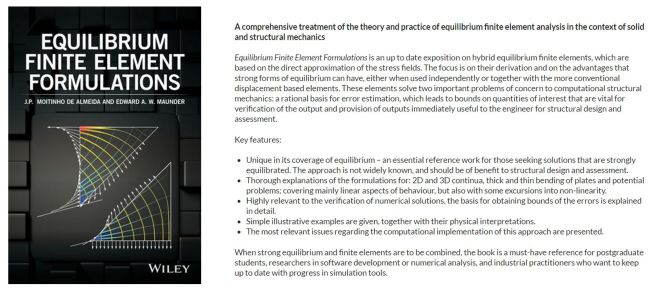Equilibrium Finite Element Formulations
Authors
J.P. Moitinho de Almeida & Edward. A.W. Maunder
Review
Equilibrium is, of course, an essential requirement of any design; if the stresses used for a design are not in balance with the loading then the designer cannot be confident that there is sufficient material to resist these stresses and the design may fail. It may surprise some that most commercial finite element systems adopt a conforming finite element (CFE) formulation that does not generally provide stresses that equilibrate with the applied load. To achieve equilibrium the mesh needs to be suitably refined and when this is not undertaken computer-aided catastrophes (CAC), such as the failure of the Sleipner A offshore gas platform, can and do occur.
The equilibrium finite element (EFE) formulation, in contrast, guarantees equilibrium irrespective of the level of mesh refinement. By using EFE models the designer can thus concentrate on the task of engineering design rather than the numerical vagaries of ensuring that the CFE model is sufficiently refined.
EFEs are not new, having been around from the early days of the finite element method. However, the more complicated mathematics and the potential presence of uncontrolled spurious kinematic modes (SKM) or internal mechanisms, led to a decline in their use and to today’s status quo where the CFE is almost ubiquitous. As a result of longstanding research in this field, the situation has now changed with the understanding of how to block spurious kinematic modes at the element level leading to meshes free of SKMs, safe for the practising engineer to realise the benefits of a fully equilibrating numerical solution to their design problem. This work has recently been published by Wiley:
The book, which requires a reasonable understanding of mechanics and the finite element method, provides a readable and complete text on the subject. The authors draw out the important aspects of equilibrium in the design process and demonstrate how this may be achieved using EFEs. Amongst others, the formulation for plates, both Kirchhoff and Reissner-Mindlin theories, is shown and the work extends through static, linear-elastic analysis into dynamic and non-linear forms of analysis. Of particular interest is the verification of numerical results so that sound simulation governance can be assured; EFEs provide a complimentary approach to CFEs where, through dual analysis, the error, even in local quantities of interest, can be bounded.
The practising engineer and their manager, responsible for the safety of a design, will learn how the crucial facet of equilibrium is often not obtained with their existing CFE software and how this could lead to CAC. They will then see that there is a viable alternative in the EFE approach. The book provides the theoretical basis of the EFE formulation that might be of interest to commercial software vendors looking to improve their offering in the market and provide a unique selling point for their product.
This book is available both as a hard copy (£75.00) and as an EBook (£67.99) and individual chapters may be purchased separately which gives a prospective reader the possibility to sample, for example, the introductory chapters prior to purchasing the entire text.

